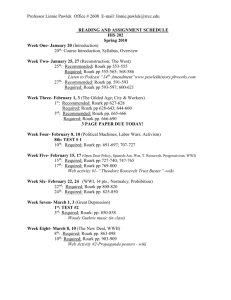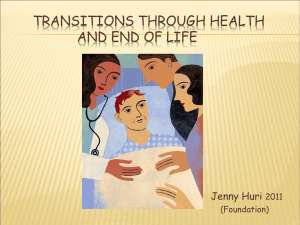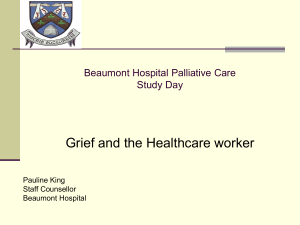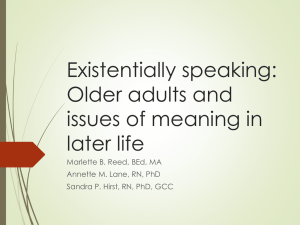Grief Process, Death and Dying
advertisement
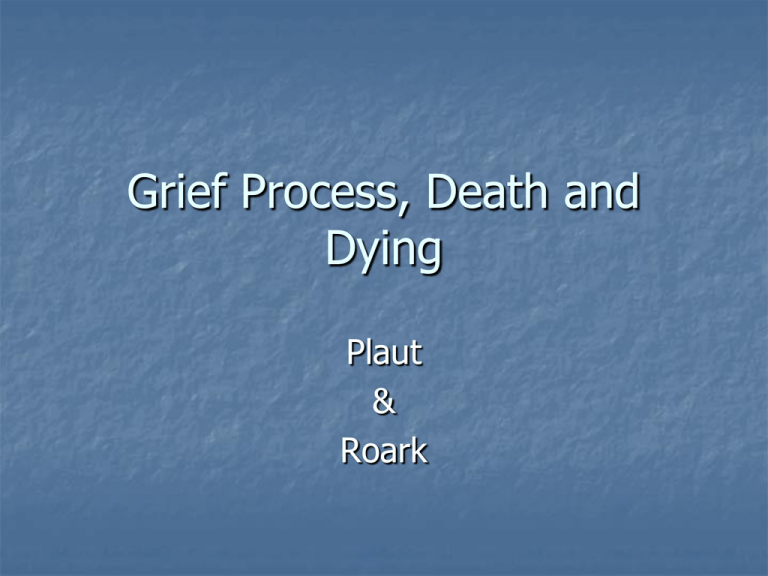
Grief Process, Death and Dying Plaut & Roark LOSS Actual Perceived External Objects Known Environment Significant Other Aspect of Self Life Roark, 2004 Kubler-Ross Stages of Grief Denial Anger Bargaining Depression Acceptance Roark, 2004 Death and Dying Assisting the patient to “Live well” and “Die well” What does this mean to you? Roark, 2004 Common fears of the dying patient Fear of Loneliness Distancing by support people and caregivers can occur Debilitation, pain, and incapacitation Hospital, a place that can be very lonely Fear of dying alone Roark, 2004 Fears of the dying client Fear of Sorrow Sadness Letting go of hopes, dreams, the future Awareness of own mortality Grief about future losses Anticipatory grief that involves mourning, coping skills Grief related to diagnosis that has a long term effect on the body such as cancer Patient may feel well at time of diagnosis Roark, 2004 Fears of the dying client Fear of the unknown: Death is an unknown state What will happen after death? What will happen to loved ones, those left behind Roark, 2004 Fears of the dying client Loss of self concept and body integrity Mutilation via therapy Body image changes Loss of role or status Loss of standard of living Roark, 2004 Fears of the dying client Fear of Regression Ego is threatened Physical deterioration may occur Mental deterioration may occur Unable to care for self Become dependent on others for care Roark, 2004 Fears of the dying client Fear of Loss of Self Control Loose ability to control life decisions Loose ability to control ADL’s Loss of control of body functions Loss of control of emotions Loss of independence Roark, 2004 Fears of the dying client Fear of Suffering and Pain May be many different types of pain or suffering such as physical, emotional, social, or spiritual in nature Altered relationships with others Anxiety related to the disease and consequences of the disease Roark, 2004 Child’s Response to Illness and Death Infant Toddler Preschool School Aged Adolescent Roark, 2004 Cultural Backgrounds Affect Beliefs Concerning Death Beliefs, attitudes, and values that stem from the patient’s cultural background will strongly influence their reaction to loss, grief, and death Expressions of grief are governed by what is acceptable by the family and within the cultural context Comfort may be found through spiritual beliefs, and finding comfort in specific rites, rituals, and practices Roark, 2004 Cultural Backgrounds Affect Beliefs Concerning Death Organized religious practices Nurses need to be in tune with patients’ spiritual needs Becoming familiar with cultural views will help… Can you name some cultural practices associated with loss, grief, and death? Roark, 2004 Support the client Nurses can help to identify coping mechanisms, and encourage effective coping mechanisms Allow client/family to visit the chapel if desired Allow family members around Client may have problems with conflicting feelings that do not align with culture or religious practices-nurse can evaluate coping and guide the client to appropriate interventions Roark, 2004 Role of the Chaplain Can be a member of the health care team Assist with religious practices Perform rites Provide prayer, support, and comfort Assist with mobilizing other support systems that are important to the client Support family members Roark, 2004 Nurses response to the dying patient Nurses grieve also Nurses need to come to terms with personal meanings of life and death Best prepared to work with terminal clients when the nurse has been given the time to come to terms with own mortality Common feelings Develop personal/professional support systems Roark, 2004 Rationale for Communicating Truthfully about Terminal Illness Right to know Time frame Nurse needs to assess whether or not the patient/family have been told and what was told to them THE PHYSICIAN WILL TELL THE CLIENT FIRST, NOT THE NURSE Roark, 2004 Communicating Terminal Illness, continued The nurse: Clarifies what was said Listens to concerns Fosters communication between MD, client, and family Allows patient to express loss Facilitate grief through nursing process Be available for patient Assist patient to identify needs/hopes for remainder of life Connect patient with proper resources Roark, 2004 List nursing strategies appropriate for grieving persons Open ended statements Patient sets the pace Accept any grief reaction Be aware—nurse may be target of anger Remove barriers Avoid giving advice Allow patient to talk Allow patient to express signs of hope Support hope by helping focus Roark, 2004 Assist Family to Grieve Explain procedures and equipment Prepare them about the dying process Involve family and arrange for visitors Encourage communication Provide daily updates Resources Do not deliver bad news when only one family member is present Roark, 2004 Choices of Care Setting Families have choices of where to care for the dying loved one Ask the patient and family preferences Support whatever the choice Hospital, Home/Hospice Roark, 2004 Elements of Hospice Care Home care coordinated with hospital Control of symptoms holistically Physician directed care Utilization of variety of health care professionals Bereavement follow up care Acceptance based on need, not $ Roark, 2004 Nursing strategies to meet physical and psychosocial needs of the dying patient Thorough pain control Maintain independence Prevent isolation Spiritual comfort Support the family Roark, 2004 Signs/Symptoms of Approaching Death Motion and sensation is gradually lost Increase in temperature Skin changes-cold, clammy Pulse-irregular, and rapid Respirations-strenuous, irregular, Cheyne stokes “Death rattle” Decrease Blood Pressure Jaw and Facial muscles relax MOST POSITIVE SIGN OF DEATH=Absence of brain waves (Need two MDs to sign off) Roark, 2004 Nursing care after death Autopsy: examination performed after a person’s death to confirm or determine cause of death For tissue and organ removal: Keep CV system going Call donor bank representative Must be agreed on by all family members Or, patient decision before death Roark, 2004 Nursing care after death Legally, a person is considered dead when there is a lack of brain waves even though other body organs continue to function This definition allows for harvesting of organs and tissue for donation Vital organs are: heart, liver, kidney, lung, pancreas Non-vital organs are: eye corneas, long bones, middle ear bones, and skin Roark, 2004 Deceased patient, before viewing the body Check orders for special requests Remove equipment Remove supplies Change soiled linens and cleanse patient Use room deodorizer Place patient in supine position, with small pillow under head Insert dentures Roark, 2004 Deceased patient, before viewing the body continued Remove valuables and give to family Stay with family, if requested After the family leaves: Tag patient according to hospital/agency policy Wrap body in shroud Put ID tag on shroud Transfer to morgue Document Roark, 2004 Describe response of family to dying process Related to cultural background Unresolved grief issues Emotions Requests Physical symptoms may occur Reorganization Individualized grief patterns Roark, 2004 Behavioral responses that obstruct the expression of grief Sudden, unexpected death Lengthy illness resulting in death Loss of a child Perception that the death was preventable Unsteady relationship with deceased Mental illness of survivor Lack of social support Roark, 2004 Thanatology Thanatology= study of death The description of study of the phenomena of death, and of psychological mechanisms for coping with death Roark, 2004 Thank you Roark, 2004
